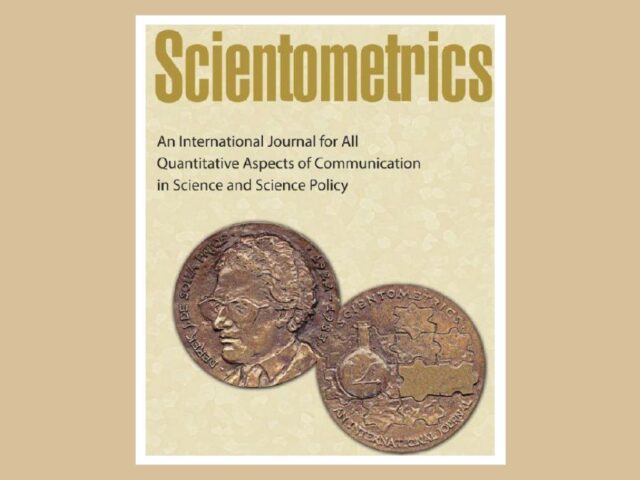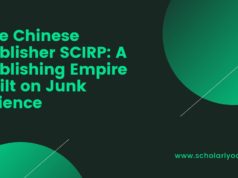
Summary: A reader of my blog alerted me to significant word-for-word plagiarism in an article published in Springer’s journal Scientometrics. I analyzed the article and confirmed plagiarism. I reported the plagiarism to the journal’s editor, András Schubert, but he responded with a condescending email dismissing the plagiarism as unimportant.
The article in question is:
Akhmat, Ghulam, Zaman, Khalie, Shukui, Tan, & Ahmed, Tauseef. (2013). Educational reforms and internationalization of universities: evidence from major regions of the world. Scientometrics 98, 2185-2205.
The plagiarism consists of multiple paragraphs copied word-for-word from other sources and strung together. The copied paragraphs do contain a citation at the end of each paragraph, but no quotation marks are used. Here is an example — The introduction paragraph is lifted from two sources. Here is the first paragraph followed by the text as it originally appeared in the original publications:


The first original source is here.
The second original source is here.
This pattern repeats itself in many paragraphs.
Next, I wrote this email to the editor and the publisher, along with one contact from Springer I made at a meeting. I copied the authors on the email. They did not respond.
I received this reply from András Schubert, the journal’s editor:
Dear Dr. Beall,
We greatly appreciate your distinguished interest in our journal and your undoubtedly well-intentioned warning about a dubious paper published in a recent issue.
As an Editor serving the journal for several decades, I have learned that the sins and virtues of authors span a rather colorful palette, and it is far not easy to make justice even in apparently obvious cases.
Plagiarism is a severe accusation which, if confirmed, cannot be relativized or exculpated. Although according to the Wikipedia “the idea [of plagiarism] remains problematic with unclear definitions and unclear rules” (http://en.wikipedia.org/wiki/Plagiarism), there appears to be an almost complete consensus, that the key criterion of plagiarism is that no credit is given to the source. As you correctly observed in your letter, this is not the case in the ominous paper.
I would say that the authors of the paper used a rather unorthodox technique in the Introduction and the Conclusion sections and the Discussion part of their paper: they compiled a large stock of relevant literature, and edited a coherent flow of text from selected paragraphs (a kind of “collage technique”) honestly indicating the sources of each of them separately. The lack of quotation marks may be objectionable, but it is questionable whether their use would have improved the readability or the credibility of the text. I would certainly not encourage other authors to follow this technique, but I cannot condemn it, either.
To be honest, using the customary way of summarizing the literature, i.e., inweaving cited text fragments (whether using quotation marks or not) into a host text, more often than not, the cited ideas are detached from their original context and serve merely as an amplifying aid to the authors’ arguments. At least, this kind of bias is avoided using full-paragraph citations.
Between the Introduction and the Discussion, the main part of the paper contains the Methodology and the Results. This part was found by two competent referees original and useful; these opinions supported the decision of the Editor-in-Chief to accept the paper. If you would happen to find any peccability in these crucial parts, this would, of course, justly question the correctness of the decision.
Anyway, we are grateful for calling our attention to the observed anomaly, and we promise to take marked attention to properly handle similar cases in the future.
Let me take the opportunity to ask you whether you would be willing to review manuscripts falling in the scope of your research competence for our journal. As a referee, you would have the opportunity to make your remarks in an early stage, thereby you could help us to improve the quality of our journal.
Sincerely yours,
András Schubert, Editor, Scientometrics
The letter essentially dismisses my report of plagiarism and does so in a patronizing way. Schubert then panders to me by inviting me to serve as a reviewer to make my “remarks in an early stage”. This invitation leads me to conclude that Scientometric’s editorial board does little or no reviewing and is chiefly honorary.
The letter also trades on an ambiguity. The definition of plagiarism is not binary, a quality that Schubert exploits to justify his inaction on the plagiarism report. By failing to use quotation marks when using the wording of others the authors of the article gave the impression that the wording they were using as their own. Failing to use quote marks is not as Schubert claims an “unorthodox technique.”

Scientometrics is published by Springer Science + Business Media for the Budapest-based Akadémiai Kiadó, a wannabe scholarly society better known as a publisher of cheap travel guides.
Based on Schubert’s statements, I think it’s fair to conclude the following:
1. If you are an author looking for an easy publication, you can copy full paragraphs from other publications (Schubert’s “collage technique”), including non-scholarly ones, without using quotation marks, as long as you put a short citation at the end of the paragraph, and submit it in an article to Scientometrics, and this won’t be a problem.
2. You can string together as many of these cut and pasted paragraphs as you like. Although, Schubert would be impressed if all this cutting and pasting produced a “coherent flow of text”.
3. Even if Schubert believes your paper is “dubious,” an “observed anomaly” and “would certainly not encourage other authors to follow this technique,” he will not take any action if your published work contains major portions of text that are word-for-word plagiarism.
4. If someone reports your work as plagiarism, the editor will likely dismiss the report and ignore COPE guidelines.












